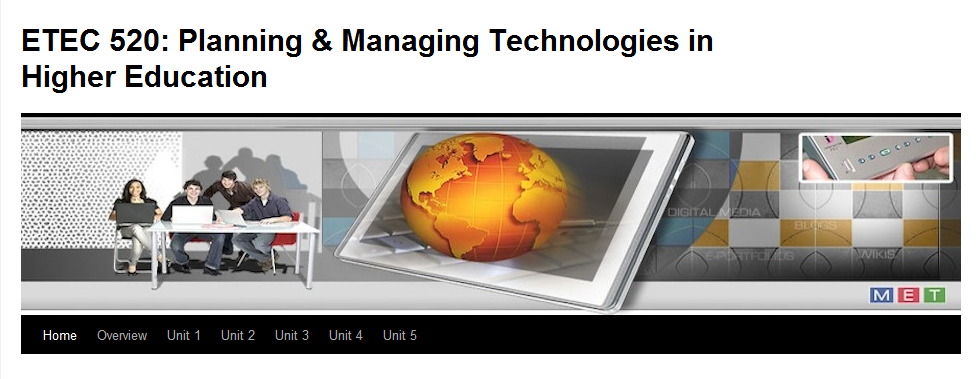Facing Reality (ETEC 520)
Realities Faced by the Pioneers
Realities faced by pioneers on their journey were often just common mistakes caused by a lack of experience of basic skills. If leadership skills were not developed there could by accidents caused by the wagons “bunching up” making it difficult for them to move. The journey could be delayed because some pioneers lacked the skills to hitch up the oxen, control the oxen team and if they didn’t have strong navigational skills they could take the wrong route. They had to work hard to keep the wagons and other tools in working order. They had to rely on each other to survive the trip.
Realities Faced by Educational Technology Pioneers
The BC Ministry of Education has recently completed its 2013-2014 Transformation Plan and have identified a number of partnership opportunities that are now being pursued with participating school districts in the province, with the goal of implementing outcomes and best practices to other districts in the future. These are the same “realities” faced by Educational Technology Pioneers as they continue on their journey of technology integration in their schools and districts. Technology needs in the areas of document/print management, unified communications, wireless network optimization, SharePoint portal development, and private Cloud data centre are among the top “barriers” faced by pioneers along with the overarching funding shortfalls for technology purchases, infrastructure and implementation.
More now than ever before there is a significant increase in the amount of digital content available to students. All of this is resulting in increased demands on current networks and this demand is expected to continue to grow at a rate of 30% per year (BC Transformation Plan). Right now, more than 25% of schools have less network capacity than an average B.C. household, and are unable to support the increase in digital content.
One of the outcomes of this new plan is the implementation of a new high-speed data network. The new network will help increase network capacity towards meeting the digital media demands within school districts (BC Transformation Plan).
Moving schools to a new network is a major, multi-year initiative. Major investment will be needed to migrate to the new network, and ensure all schools have the technology infrastructure required to access digital content equally across the province. Without this investment, it will be impossible to meet the demands for digital learning content, and could hinder the progress of education transformation. As well, adoption of many shared services also requires investment in network capacity (BC Transformation Plan).
Generating and implementing new ideas is a significant aspect of the business transformation as we move away from the “business as usual” approach to a personalized services way of business. The workspace redesign was a significant initiative undertaken by the Ministry to provide staff with some foundational elements to work into everyday business and encourage new ideas. Furthermore, the evolution and further integration of technology is pivotal in providing avenues to exchange information and ideas (BC Transformation Plan).
 ETEC 520: Planning and Managing Learning Technologies in Higher Education (elective course)
ETEC 520: Planning and Managing Learning Technologies in Higher Education (elective course)
This course focused on the management of technology-based courses and projects, strategies for change needed at an institutional level to support technology-based teaching, and system-wide planning requirements at a provincial, state or national levels to support and regulate distributed learning. The course used both Internet and print resources through which to analyze and critique different management and planning strategies at various levels of technology-based operation.
Artifacts
Artifact 1: A Vision for E-Learning in the Faculty of Education at Vancouver Island University
General Reflection:
- I think the Lone Ranger approach, as described in Bates and Sangra (2011, pg. 138), is alive and well, at least in my institution. In my workplace there are many contractual rules about processes, procedures and job duties, but there is also a lot of innovation going on in schools that would easily fit into the Lone Ranger approach. These individuals are using minimal to no funding, they are engaging students with e-learning technology and are seeing results of their innovations.I found an article online by Whitworth and Benson (2007) titled Taming the Lone Ranger, These authors call for higher education institutions to continue the funding for Lone Ranger approaches despite the fact that Bates (2000) says that institutions should outgrow the need for these “seed grants” that produce amateur results. Whitworth and Benson (2007) contend that there is a need for creativity to “bloom” somewhere and that the funding for these teaching-focused entrepreneurs should co-exist with the institutions larger plans for e-learning (if there are any they say).It was an interesting read with some interesting case studies. However, Bates and Sangra (2011) delineate five separate approaches to course development and delivery of which the Lone Ranger method is but one. However I like aspects of each of the methods outlined.
Reflecting toward the future:
What do I see as the supports that would help me to further cultivate my practice of pioneering leadership?
- If I learned anything in this course I certainly gained a thorough understanding of how important it is to get to know the “pioneers” who hold the authority in the system. I only say this because in order to make a shift you have to work with the people who are the visionaries and once you understand the focus of the group who are “already moving” only then will you be able to get in there, ask questions, and suggest subtle changes in the plans.
- Therefore, in order to further cultivate my pioneering leadership I will have to continually get to know the leaders in the system and find ways of working with them. It is only then that I will have some sphere of influence.
How does theory learned in this course offer me insights about how I might nurture a change in the culture of my community?
- The development of a sound strategic plan is necessary in order to systematically enhance course development and bring administration, professors, support staff and students together in the pursuit of common e-learning goals. A strategic plan is “key” and would provide a response to the needs of faculty, staff, and administration and include the needs of current and prospective students. E-learning would therefore be seen as a strategic investment that has the potential to create a competitive advantage and the potential to generate revenue (Mendling, Neumann, Simon, & Pinterits, 2005). Therefore, a strategic plan would address professors’ perceived lack of time, incentives and sufficient technology to assist with developing their e-learning literacy.
Implementation, surprises, and consequences? Regrets?
- The implementation of an e-learning strategy can provide a model through which students become self-directed independent learners and may even assist them in becoming life-long learners who will consequently become excellent classroom teachers.
- It wasn’t a surprise, but I confirmed for professors, e-learning will most likely initiate unwanted changes in work patterns and changes to their professional role, but it can also provide them with new opportunities to engage students in developing their own e-pedagogy and teaching strategies so they will be better able to meet the diverse needs of their future students.
- Again, no surprise that the role of the professor will remain crucial in the successful delivery of e-learning initiatives within the faculty as they have the influence to empower and encourage students to interact and construct knowledge with one another.
- Finally, a viable option to lure students back to the Faculty of Education may be to utilize e-learning tools to develop and implement a “course recovery” program for students who, due to extenuating circumstances, didn’t complete parts of courses or programs.
- No regrets!
How does this project affect practice or what new perspectives have you discovered in reflection?
- Through this course I came to believe that any faculty could incorporate e-learning successfully by developing and implementing a clear vision of e-learning leading to a collaboratively developed strategic plan with realistic and measurable goals. The strategic plan would need to be aimed at addressing identified external and internal factors thereby increasing the potential for greater student enrollment.
- As Hepp, Hinostroza, Laval, and Rehbein (2004) suggest, once the faculty knows and understands its goals and purpose, it can begin to define itself in both the short and long term (p. 49).
Next Steps:
- I need to be part of the planning group. Therefore, so I don’t get frustrated waiting for what I believe needs to happen, I actually need to commit and join the working group.
- I need to step forth and take on a leadership role despite the added work this would entail.
| Pioneer Trail | ||||
| Bullet Trail |

